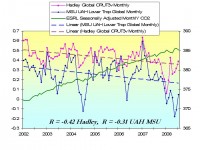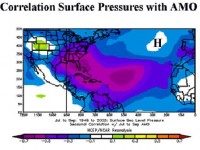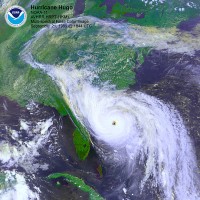May 29, 2008
Correlation of Carbon Dioxide with Temperatures Negative Again
By Joseph D’Aleo, CCM
The temperatures over the last century correlated positively with carbon dioxide in the early 20th century but that warming was acknowledged even by the IPCC to be largely natural and minimally anthropogenic.
A negative correlation existed from the early 1930s to the late 1970s as temperatures cooled. This included three decades of the post war economic boom. A very strong positive correlation resumed after the Great Pacific Climate shift in the late 1970s. Data here is the USHCN Version 2.

See full size image here
After 1998, temperatures stopped rising and since 2002 have been falling now into the 7th year. Meanwhile CO2 has continued to rise (9.69 ppm or 2.6%) although the Mauna Loa surface data has actually paused this year with the La Nina inspired cooling. The monthly global data is plotted here for Hadley and UAH MSU along the monthly seasonally adjusted CO2 from NOAA ESRL for Mauna Loa. There is no smoothing here of the monthly data. The correlation (Pearson coefficient, r) for the Hadley and CO2 is now a negative (minus 0.4) and for the MSU UAH (minus 0.21). As we have noted, this MAY mark the start of another cooling interlude as predicted by the 60-70 year cycles of the PDO and AMO, and diminished solar.

See full size image here
The on again, off again nature of this correlation suggests that carbon dioxide is not the driving factor in our climate. See pdf here.
May 25, 2008
31,000 Scientists Reject ‘Global Warming’ Agenda
By Bob Unruh, Worldnet Daily
More than 31,000 scientists across the U.S. - including more than 9,000 Ph.D.s in fields such as atmospheric science, climatology, Earth science, environment and dozens of other specialties - have signed a petition rejecting “global warming,” the assumption that the human production of greenhouse gases is damaging Earth’s climate.
“There is no convincing scientific evidence that human release of carbon dioxide, methane, or other greenhouse gases is causing or will, in the foreseeable future, cause catastrophic heating of the Earth’s atmosphere and disruption of the Earth’s climate,” the petition states. “Moreover, there is substantial scientific evidence that increases in atmospheric carbon dioxide produce many beneficial effects upon the natural plant and animal environments of the Earth.”
“Mr. Gore’s movie, asserting a ‘consensus’ and ‘settled science’ in agreement about human-caused global warming, conveyed the claims about human-caused global warming to ordinary movie goers and to public school children, to whom the film was widely distributed. Unfortunately, Mr. Gore’s movie contains many very serious incorrect claims which no informed, honest scientist could endorse,” said project spokesman and founder Art Robinson. WND submitted a request to Gore’s office for comment but did not get a response.
Robinson said the dire warnings about “global warming” have gone far beyond semantics or scientific discussion now to the point they are actually endangering people. “The campaign to severely ration hydrocarbon energy technology has now been markedly expanded,” he said. “In the course of this campaign, many scientifically invalid claims about impending climate emergencies are being made.
Simultaneously, proposed political actions to severely reduce hydrocarbon use now threaten the prosperity of Americans and the very existence of hundreds of millions of people in poorer countries,” he said. Read more here.
May 25, 2008
Ocean Cycles and Atlantic Hurricanes - an East Coast Threat in 2008?
By Joseph D’Aleo, CCM
In recent weeks we have posted stories about the Pacific Decadal Oscillation, the Atlantic Multidecadal Oscillation and ENSO and their effects on temperatures and Greenland and Arctic ice.
In this story, we look at how these same ocean cyclical oscillations influence the relative frequency of tropical storms, the number of strong storms and the most likely storm tracks and areas affected.
In recent months we have seen two prominent scientists (MIT’s Kerry Emanuel and NOAA’s Tom Knutson of the fluid dynamics lab at Princeton) who had earlier published papers linking global warming with increased Atlantic hurricane frequency and strength change their position on the basis of new data or models. We applaud these scientists for being willing to change their opinion when presented with conflicting data.
We believe these varying cycles of activity and tracks relate mainly to natural cyclical changes in the oceans. Dr. Bill Gray has shown how the frequency of Atlantic hurricanes and major hurricanes increase dramatically during the warm AMO phase (the case since 1995). We can see that surface pressure during hurricane season tends to be lower in the western Atlantic and Gulf when the Atlantic is in its warm mode (positive AMO).

See full size here
In the cool PDO, there are more La Ninas and La Ninas favor more hurricanes due to less shear and storms threaten not only the Gulf as we find in El Ninos but are much more common along the East Coast from Florida to the Carolinas to New England.

See full size here
If La Nina holds on and the AMO, which has weakened, rebounds (as it did in the La Nina summer of 1955), both the Gulf and the East Coast need to be wary this summer and fall more than in most years. See why here.

See Hurricane Hugo full size here
May 24, 2008
Sunspot Cycles May Hold Key to Global Warming, Cooling
Op Ed in Eau Claire, WI Leader Telegram
The 2008 winter was the coldest in 40 years for the upper Midwest, Plains states and most of Canada. Minnesota newspapers report that this year’s opening of the locks to Mississippi barge traffic, delayed by three weeks, was the latest since the modern waterway opened in 1940. Eau Claire, where “old-fashioned winters” have been a thing of the past, recorded 43 days of below-zero temperatures, while folks down in Madison shoveled away at a 117-year record snowfall throughout the season, as did many in New England and Canada.
Rare snowfalls struck Buenos Aires, Capetown, and Sidney during their mid-year winter, while China continually battled blizzards. Even Baghdad experienced measurable snowfall. Antarctic pack-ice far exceeded what Captain Cook saw on his 18th century voyage into the Southern Ocean. On the continent itself the miles-thick ice continues to accumulate despite peripheral melting along the Antarctic Peninsula and occasional calving of an ice block. At the opposite pole, flow-ice once again spans the entire Arctic Ocean, and by April it had extended into the Bering Strait, making up for the much heralded melt-back last summer.
Past cool periods, identified with the late stages of the “Little Ice Age” and with the Maunder and Dalton climate minima, closely correlate with low sunspot numbers (astronomers have kept close tabs on sunspots since Galileo’s time). Some solar-physicists are now saying if the current cycle doesn’t begin to produce spots soon, we can expect a cool-down like the 19th-Century Dalton minimum - or worse. Decades-long cooling in the past brought crop failures to Europe from repeated summer frosts and restricted growing seasons.
With grain shortages already staring us in the face, we’d be advised to begin thinking about a global cool-down instead of a warming that may or may not continue. We might consider ways to transform semi-desert into arable land and to develop seed with shorter maturing cycles suitable for a sub-boreal grain belt. If cooling should begin in earnest, we will quickly forget global warming as we face the new challenges ahead. Read more here.
May 21, 2008
Brr! The Climate Cools for Reality-Deniers
By Melanie Phillips, UK Spectator
I have previously written about the work of Lawrence Solomon for Canada’s National Post. He has been regularly charting in his column the ever-increasing number of climate scientists around the world who have been either crying foul about the man-made global warming scam or, having initially signed up to it, have been having second thoughts about it. This was a journey of discovery for him, to put it mildly; he had previously been inclined to believe the claims that ‘deniers’ were oil industry stooges, since he himself had worked for an anti-nuclear energy group and so was duly cynical about the way that industry’s scientists could twist the truth to suit their paymasters. But then to his astonishment he discovered that, when it came to MMGW, the scientists who were corrupt weren’t pushing the boat out for big business but for its holier-than-thou green challengers.
Now he has written a book, provocatively entitled The Deniers, in which he shows that not only is the fabled climate change ‘consensus’ itself a sham but the so-called MMGW ‘deniers’ are by far the more accomplished and distinguished scientists than those pushing the theory as a settled and incontrovertible truth. A number of them indeed, are so eminent they were used as experts by the IPCC - but then came to realise that this was an innately corrupted process and that even some of their own work was being abused and distorted in order to promulgate the false doctrine of MMGW.
Meanwhile, the carbon really has hit the fan with the highly inconvenient truth that global temperatures are not only currently static but are predicted not to rise at all for the next decade. Andrew Bolt links to a debate on the Politics and Environment blog between climate change believers who are trying to reconcile the IPCC predictions with reality. Officially, the greens are claiming that the prediction that rising CO2 inevitably meant rising temperatures always allowed for, er, pauses. Of a decade. But in the P&E debate, there is the distant clang of a spade being called a spade: The IPCC projections remain falsified. Where now is that fabled ‘consensus’ when it is urgently needed to defend all those reputations which depend upon it? You’d have to have a heart of Antarctic ice not to laugh.
Read more here.
|







